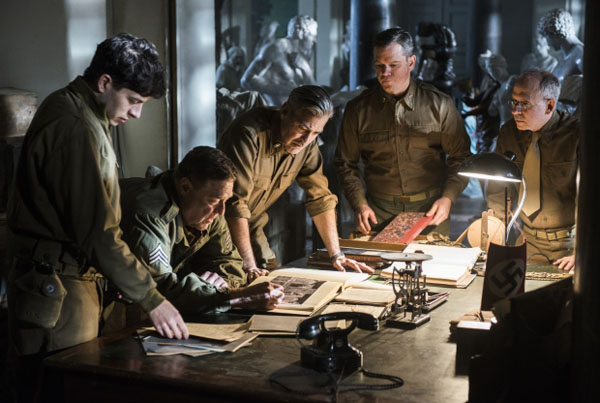Uh-oh. We begin with Variety‘s Scott Foundas: “It’s not only the great works of European art that have gone missing in The Monuments Men; the spark of writer-director-star George Clooney’s filmmaking is absent, too…. When Clooney started out as a director, it was clear he’d learned a great deal about technique from his many collaborations with Steven Soderbergh, and his first two features, Confessions of a Dangerous Mind (2002) and Good Night, and Good Luck (2005), were compelling evidence that the pupil might be as good as the master. Though wildly divergent in tone, both those movies were inventive biopics set against the backdrop of live television production—a world Clooney grew up in—and Confessions in particular seemed informed stylistically by the fast pace and self-reflexivity of live TV. But The Ides of March and now The Monuments Men are likes movies made by someone else: dutiful, establishment prestige pictures with ‘big’ ideas communicated in thuddingly literal fashion. In short, if Clooney started out as Soderbergh, somewhere along the way he seems to have turned into ’80s-era Norman Jewison.” Ouch.
“To be sure, it’s a fascinating story,” writes Todd McCarthy in the Hollywood Reporter, “one touched upon in a central way only once before in a major Hollywood movie, John Frankenheimer’s sensationally good The Train, starring Burt Lancaster and Paul Scofield, in 1964. Whereas that was a breathless thriller, The Monuments Men is more of a procedural, in which a band of middle-aged scholars, led by art historian Frank Stokes (played by Clooney as a fictionalized version of Harvard art conservationist George Stout, a handsome moustachio-ed man in real life himself), receive the blessing of FDR himself to enter the war zones of Europe to do what they can to save the Western art Hitler has been amassing to fill his planned Fuhrer Museum in Germany.”
“The Monuments Men tries to mix humor and drama, Dirty Dozen-style heroics and Ocean’s Eleven-esque charm, failing to ever properly land on one consistent tone or direction,” finds Tim Grierson, writing for Screen Daily. “Clooney’s film features a measured pace and a somewhat contemplative atmosphere, giving each of the characters substantial screen time as they go about their different missions. But the movie’s offhand observations about the lunacy of war and the value of art fail to cut very deeply. Likewise, none of the characters leave much of an impression.”
As for that roster of characters, McCarthy has the most succinct rundown: “There’s straight-laced art expert James Granger (Matt Damon), architect Richard Cambell (Bill Murray), sculptor Walter Garfield (John Goodman), French art dealer Jean Claude Clermont (Jean Dujardin), art historian Preston Savitz (Bob Balaban) and British art wingman Donald Jeffries (Hugh Bonneville); they’re joined by a virtual kid, Sam Epstein (Dimitri Leonidas), a German Jew who will translate and drive.”
“These guys are supposedly the best in their respective fields, but they’re lousy soldiers, and try as Clooney might, with soaring musical cues from Alexandre Desplat, and inspirational voiceover narration, and shots of a billowing American flag, it’s awfully hard to give a shit about whether they live or die and whether or not they succeed in their mission. Especially since, you know, the Holocaust.” At the Playlist, Drew Taylor gives The Monuments Men a B-.
“It’s a big old creaky airplane that never achieves liftoff,” finds Anne Thompson. Alonso Duralde at TheWrap: “There’s not a single visual jolt or surprise to be found here—not that there’s necessarily anything wrong with that, but Clooney’s visual straightforwardness only underscores the script’s weaknesses.” At In Contention, Kristopher Tapley is among the many who spare a few kind words for the work of cinematographer Phedon Papamichael.
For background on the real-life story behind the movie, see Rafael Medoff in Tablet and Lynn H. Nicholas in the Wall Street Journal.
Update, 1/30: Time Out‘s Keith Uhlich finds that Clooney “gets great work from Bonneville (now best known from Downton Abbey)—notably in an emotionally charged scene revolving around Michelangelo’s Madonna of Bruges—and has a fine monologue himself, in which Stokes dresses down a high-ranking German commander (a moving encapsulation of the American spirit at its best). You wish that same sober confidence extended to the rest of the film, which is otherwise content to be another slipshod and banal, if always watchable, Hollywood co-opting of history.”
Updates, 3/1: More reviews have come in from Jesse Cataldo (Slant, 2/4), William Goss (Film.com, 5.9/10), Robert Horton (Herald), Mark Kermode (Observer, 3/5), Andrew O’Hehir (Salon), Andrew Pulver (Guardian, 2/5), Nathan Rabin (Dissolve, 2/5), Tim Robey (Telegraph, 2/5), Matt Zoller Seitz (RogerEbert.com, 2.5/4), Tom Shone (Guardian, 1/5) and Scott Wilson (Nashville Scene).
Ramin Setoodeh interviews Clooney for a Variety cover story.
For news and tips throughout the day every day, follow @KeyframeDaily on Twitter and/or the RSS feed. Get Keyframe Daily in your inbox by signing in at fandor.com/daily.




